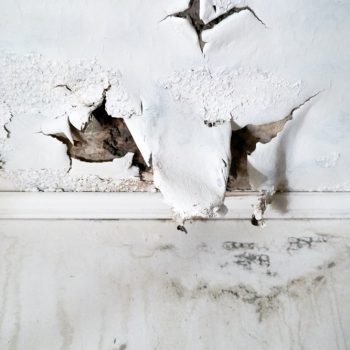Does your roof have moisture damage?
Unfortunately, the headache of moisture-damaged roofs is something many properties face, arising in buildings of all ages and affecting most roofs during their lifecycle. It’s an issue that needs addressing as soon as possible, as water-damaged roofs can be costly to fix if left to deteriorate, leading to far greater problems.
Here’s how to spot and repair moisture damage on roofs.
 What causes moisture damage on roofs?
What causes moisture damage on roofs?
Every roof will go through periods each year where it’s exposed to increased moisture levels, depending on the season. However, the normal climate cycles in the UK allow roofs to dry naturally, preventing damage. Issues start when the moisture level exceeds the average volume, penetrating the roof and creating long-term concerns.
Ongoing moisture penetration can be caused by a range of factors, including existing damage or deterioration of the roof. This happens when small gaps aren’t spotted (resulting in roof leaks) or the roofing material is coming to the end of its lifespan. Problems can also occur when gutters are clogged on low-sloping roofs.
Once moisture damage sets in, the problem will only worsen, keeping the roof in a vicious cycle. For example, moss spreads fast in wet conditions while trapping moisture itself. You can also get moisture problems if anything hasn’t been properly installed, such as roof vents, which are required for adequate air circulation.
Problems with moisture-damaged roofs
Moisture damaged roofs can become costly nightmares if left unaddressed. Even if the issue starts as a minor one, things will soon become more significant if you don’t rectify it.
Firstly, the moisture creates the perfect breeding ground for algae to grow and rapidly spread, resulting in surface damage, like roof tile displacement. This can shorten the lifespan of your roof.
Moisture can also cause deeper instability, damaging the interior roof structure if it reaches any wood or timber below the surface. You may also discover issues within your loft or attic space, such as mould, posing a potential health risk.
How to protect your roof from moisture and water damage
You can protect your roof from moisture via a number of methods. Good ventilation and air circulation are the key to drying your roof out, so always keep an eye out for issues like leaks and damp patches in your attic, indicating your roof system isn’t working as it should.
If you detect moisture damage early, it can usually be rectified, emphasising the importance of regular roof inspections. If your roofer finds something small, they’ll advise you about your options. However, it’s always best to fix problems as soon as you spot them, or they could lead to a lot of stress and repair costs further down the line.
Think you have a roof issue? Contact Collier Roofing
If you think your roof is moisture damaged or you’d like to book an inspection, contact the team at Collier Roofing. We offer expert roofing solutions across London and Surrey, including Croydon and Godstone.
For a free quote, please get in touch.
